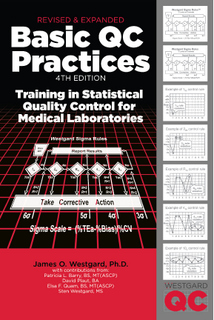Basic QC Practices
QC - The Out-of-Control Problem
What do you do when you're control is out-of-control? Conventional wisdom is that you repeat the control or try a new one. But that ignores the problem. It doesn't solve anything. Elsa P. Quam BS, MT(ASCP) explains what bad habits we have and what good habits we can adopt to make our laboratory practice better
To read the most up to date version of this lesson, we invite you to purchase the Basic QC Practices manual, Fourth Edition, or join the Basic QC Practices online course.
QC - The Out-of-Control Problem
Change Old Bad Habits - Recognize Problems:
Develop Good Habits - Solve Problems:
- Good Habit #1: Inspect control charts or rules violated to determine type or error
- Good Habit #2: Relate type of error to possible causes
- Good Habit #3: Consider factors in common on multitest systems
- Good Habit #4: Relate causes to recent changes
- Good Habit #5: Verify the solution and document the remedy
In routine operation of a quality control (QC) procedure, the control materials are analyzed before or during the analytical run, the control results are recorded and plotted on control charts, and control status is determined by inspecting the control data using the control rules (control limits) selected. If the control results are "in", the run is accepted and patient samples can be assayed or reported. If the control results are "out", the run is rejected, the problem is identified and resolved, and the a new run can begin or, in the case of batch assays, a run of patient samples can be repeated. This is the way control procedures are "supposed" to work.
Change Old Habits - Recognize Problems
Current QC practice does not always follow these guidelines. All too often, the first response to an "out of control" situation is to automatically repeat the control or "try it again". A 1994 CAP Q-Probe, aimed at identifying quality control exception practices, found that most laboratories simply reran controls to resolve out-of-control events [1]. Guidelines for corrective actions in out of control situations often suggest repeating the controls before inspecting the control charts or looking at the type of rule causing the rejection [2]. By automatically repeating the controls, we are saying that we don't trust the control procedure to do its job, i.e., provide a certain level of error detection at an acceptablly low rate of false rejections. If QC procedures have been carefully planned on a test by test basis, taking into account the quality required for each test and the performance capabilities of the test method, then the error detection capability should have been maximized and the false rejection rate should have been minimized. We can then trust the QC procedure to do its job and detect problems. Our job should then be to solve the problems and eliminate the causes or errors [3].
Bad Habit #1: Repeat the control
Simply repeating the controls is an outdated practice that can be traced to the use of 2s control limits, or the 12s control rule, whose false rejection rate is 5% for N=1, 9% for N=2, and 14% for N=3. The false rejection rate for a 13s control rule is only 0.3 % or 3 chances in a 1000! Logic should tell us to believe in what the control results are indicating. While repeating the control will often give us a value that may be "within the limits", careful inspection of the actual repeat result will often show that "we may have just squeaked by" and what we really have done is to delayed the troubleshooting and problem solving until a future run.

For example, the graphic here shows the expected distribution of control results for a systematic error that causes the mean to shift by 2 times the standard deviation of the method. For the 1st out-of-control event, the next control point shows that a repeat of the control is okay. For the 2nd out-of-control result, a repeat would again be okay. For the 3rd and 4th events, repeats would again be okay. For the 5th event, the first repeat is still out, but not quite as far; a second repeat is still out but better; a third repeat is finally in, so everthing now is okay. Right? Obviously not! When you see all these control results displayed on the chart, it is clear there is an analytical problem that needs to be identified and fixed. The practice of repeating the control just puts off the resolution of the problem.
We invite you to read the complete lesson
 To read the entire, updated version of this article, we invite you to purchase the Basic QC Practices manual, Third edition, or join the Basic QC Practices online course.
To read the entire, updated version of this article, we invite you to purchase the Basic QC Practices manual, Third edition, or join the Basic QC Practices online course.

